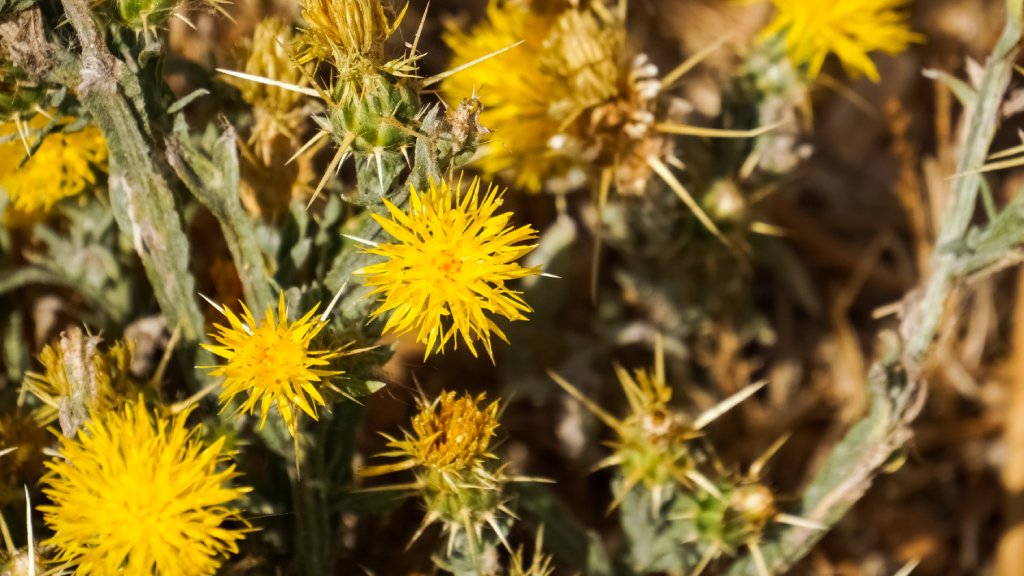Yellow Starthistle: Identification & Control Methods
Yellow Starthistle is a noxious invasive weed that steals nutrients and moisture from other plants and is poisonous to horses.


Yellow starthistle is identified as one of the most serious weeds in the Western U.S. Although it is an annual plant, it spreads rapidly and produces an extensive amount of seed. Its control is of paramount importance because it threatens the desirable vegetation in rangeland, natural areas and roadways. Learn how to slow down this invasive plant.
Quick Facts about Yellow Starthistle:
- Botanical name: Centaurea solstitialis
- Height: 6 inches to 6 feet (15 cm to 1.8 m)
- Spread: Branching spines
- Sun exposure: Full Sun
- Soil requirements: Well-drained fertile or poor soil
- Hardiness zones: USDA 5 to 9; UK Zone 6
- When to plant: Sow seeds in spring
Yellow Starthistle: Identification & Control Methods
Yellow starthistle (Centaurea solstitialis) is considered a noxious weed in 12 Western and upper Midwest states. An eradication program is recommended as soon as the annual (sometimes biennial) yellow thistle plant is recognized growing on a person’s property.
Why is yellow starthistle a problem? Its aggressive spread takes a firm hold, impacting native flora and fauna. Also known as Barnaby’s thistle, golden starthistle, or yellow knapweed, it sends deep roots into the soil, depleting the moisture so no other plant species can establish. It outcompetes native plants for nutrients and space.
Info About Centaurea Solstitialis
While yellow starthistle has some wildlife value, it is poisonous to horses, and they should not be allowed to graze in infested fields. If consumed by horses, it causes a fatal neurological disorder known as “chewing disease,” which leaves horses unable to chew or swallow. However, sheep, goats, and cattle can safely graze on yellow starthistle to help control its spread.
Identification of Yellow Starthistle
The gray-green to blue-green annual can grow up to 6 feet tall (1.8 meters) with stiff, branching stems and side wings. In fall and winter it forms a basal rosette of ruffled leaves, then flowers in spring. The yellow flowers are thistle like, with sharp spines protruding in a star shape below the flowers. Leaves are alternate and, along with the stems, are covered in whitish hairs. Its vigorous taproot can descend more than 36 inches (.9 m).
Habitat & Growing Conditions
The Eurasian native was accidentally introduced into California around 1850 and quickly spread. It is now common in most states along roadsides, fields, pastures, rangeland, desert, and waste areas. It prefers a well-drained soil in full sun but is not picky about soil conditions or alkalinity. It tolerates poor soil and drought. However, it will not grow in shade.
How Does Yellow Starthistle Spread?
Yellow starthistle spreads solely by seed and can produce 30,000 seeds per square meter. The seeds can germinate immediately or remain viable in the soil for up to 10 years in certain environmental conditions. Typically they are viable for only 4 years. Mature seed heads turn straw colored and drop seed within a small area. The seed is carried further on shoes, clothes, fur, hair, road vehicles, and equipment.
Sign up for the Gardening Know How newsletter today and receive a free copy of our e-book "How to Grow Delicious Tomatoes".
How to Get Rid of Yellow Starthistle
A yellow starthistle invasive species management program should begin as soon as a population is identified. Begin with the smaller infestations, then move on to larger populations. Yellow starthistle control may include mechanical, cultural, biological, and chemical means of management. Keep annual records of infestations and continue to monitor areas once under control. Have a plan to combat missed areas or seedlings.
To control yellow starthistle in a small space, pull the plants before they go to seed and dispose of them.
Here are suggested control methods for large areas:
- Mechanical - Pulling, mowing, or cultivating to eliminate seed can reduce or eliminate an infestation in two to three years.
- Cultural - Cattle, sheep, or goats can effectively reduce an infestation if they are allowed to graze in short bouts of high intensity. Goats are not bothered by the spines that appear on the flowers and will continue to graze while other animals will not. Grazing should occur when the stems are beginning to bolt but before the spines grow. Prescribed burns can be effective if they’re timed when the yellow starthistle plants are just beginning the flowering stage.
- Biological - In the Western U.S., six insects have been released to curtail the spread of yellow starthistle by attacking the seedheads. Of the three species of weevils and three species of flies, only two of them, the hairy weevil and the false peacock fly, make a respectable dent in seed production. However, they can be useful in an integrated management program.
- Chemical - Yellow starthistle herbicide control can include selective, post-emergent herbicides applied to young plants in the seedling to rosette stage or later when growing 4 to 6 inches (10 to 15 cm). Once the plants are flowering, herbicides are ineffective on annuals.
Note: Any recommendations pertaining to the use of chemicals are for informational purposes only. Chemical control should only be used as a last resort, as organic approaches are safer and more environmentally friendly.

After graduating from Oklahoma State University with a degree in English, Susan pursued a career in communications. In addition, she wrote garden articles for magazines and authored a newspaper gardening column for many years. She contributed South-Central regional gardening columns for four years to Lowes.com. While living in Oklahoma, she served as a master gardener for 17 years.